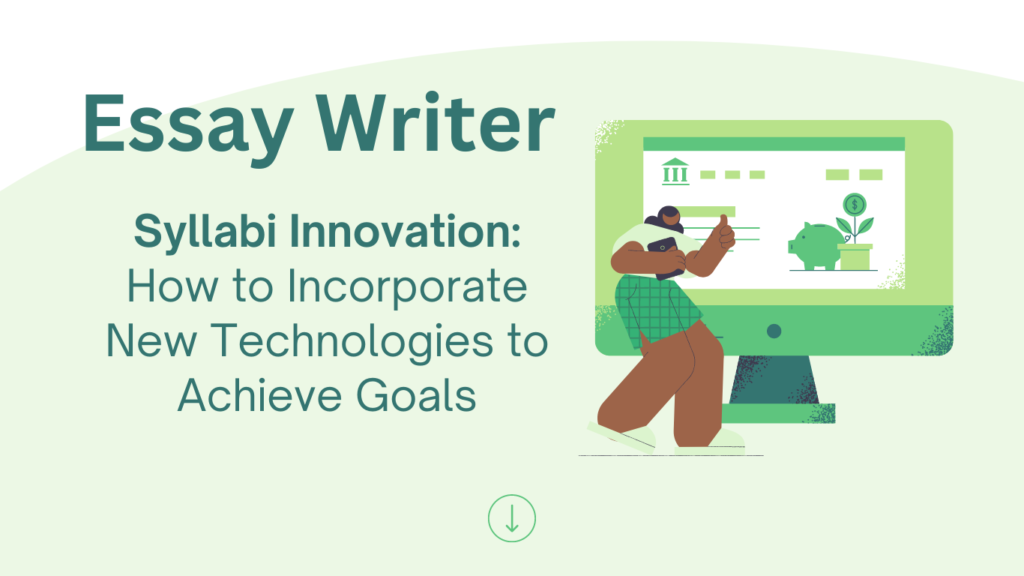


Syllabi are more than just documents that outline the course content, objectives, and policies. They are also powerful tools that can shape the learning experience and outcomes of students and instructors.
In this article, we will explore how syllabus innovation can help you incorporate new technologies into your course design and delivery, and how this can benefit your teaching and learning goals. We will also discuss some examples of digital tools, online platforms, multimedia elements, artificial intelligence, and machine learning that can enhance your syllabus and your course. If you need are stuck in how to comprehend syllabus complex jargons feel free to take a look at essay writer, where you can learn amazing techniques and expert guidance and guess what, almost free of cost.
Syllabi is a plural form of the syllabus. A syllabus is an outline or a summary of the main points of a text, lecture, course of study, or exam. It may also show the subjects or books to be studied in a particular course.
Syllabi is very important as it provides a layout, course content, objectives, and setting up goals.
The importance of syllabi in an academic career is as follows.
The following table shows how your essay writing skill is enhanced with the help of provided syllabi by any institution.
| Syllabi Goal | Essay Learning Outcome | Objective |
| Outline & Structure | Set up the purpose of the essay based on the course outline of the syllabus |
| Planning & Scheduling | Setting up due dates and other requirements based on your writing process |
| Content | The syllabus contain all necessary information, objectives, policies, and relevant data for any essay |
| Material Guidelines | reference books, instructor contact information, recommendations, essay-related articles |
| Policies and principles | Policies, the structure of the essay, format, subject relevancy |
| New Technologies & Pedagogies | Incorporation of new technologies, like digital tools, online platforms, multimedia platforms, artificial intelligence, and machine learning. |
Syllabi and the incorporation of new technology are related to essay writing in several ways. Syllabus can help you understand the purpose, goals, requirements, and expectations of your essay assignment, as well as provide you with the resources and support for essay writing. Incorporation of new technology can help you improve your essay quality – where to use MLA vs APA format and feedback, collaborate and share your essay ideas, enhance your essay content and presentation, generate and evaluate your essay ideas, and align your essay with the latest trends and developments in educational technology. Here are some examples and headings that illustrate these points:
It helps you understand the purpose and goal which is very useful in staying connected with your goal and focusing on your topic and argument. This is really useful regarding learning outcomes and grading criteria for your assignment.
Multimedia and interactive elements are powerful tools to enhance syllabus. They can help you present your course content in more appealing and effective ways, and provide more opportunities to interact with.
Some examples of multimedia and interactive elements that you can incorporate into your syllabi are:
– Color, themes, visuals, and graphics to make your syllabus more attractive and organized.
– Hyperlinks, QR codes, or table of contents to make your syllabus more accessible and navigable.
– Teasers, promotions, or questions to spark your student’s curiosity and interest in the upcoming topics or assignments.
– Resources, such as glossaries, maps, videos, podcasts, or websites, to support your students’ learning and understanding of the course content.
– Learning guides, such as rubrics, checklists, templates, or examples, to help your students complete the assignments successfully.
– Spaces or tools for notes, reflection, self-assessment, or tracking progress to encourage your students’ metacognition and feedback.
To incorporate multimedia and interactive elements in your syllabi, you can use various tools and software, such as
Things to keep in mind:
By incorporating multimedia and interactive elements in your syllabus, you can create a more engaging and innovative learning environment for your students. You can also foster a student-centered approach that promotes their autonomy and motivation in learning.
Artificial intelligence and machine learning are very helpful and here are some advantages of using it.
AI-based personal assistants like Siri and Alexa can help create and evaluate syllabi by providing voice-based interaction, natural language processing, and information retrieval.
For example,
an instructor can ask Siri to create a syllabus outline based on the course objectives, learning outcomes, and assessment methods.
Siri can then generate a draft syllabus that the instructor can review and edit.
A learner can ask Alexa to evaluate their syllabus by asking questions like “What are the main topics covered in this course?” or “How will I be graded in this course?”. Alexa can then provide feedback and suggestions based on the syllabus content.
In conclusion, syllabi innovation is a process of incorporating new technologies to achieve the goals of teaching and learning. It involves identifying the needs and expectations of the instructors and learners, selecting the appropriate technologies that can enhance content and delivery, and evaluating the outcomes and impacts of the innovation. Moreover, it can offer many benefits, such as increasing engagement, motivation, collaboration, feedback, and personalization. However, it also poses some challenges, such as ensuring accessibility, quality, ethics, and security. Therefore, syllabi innovation requires careful planning, implementation, and assessment to ensure its effectiveness and sustainability. Innovation is not a one-time event, but a continuous cycle of improvement and adaptation to the changing needs and demands of the educational environment. By embracing new challenges, instructors and learners can leverage the potential of new technologies to achieve their goals and enhance their experiences.